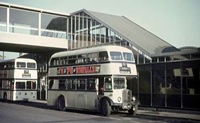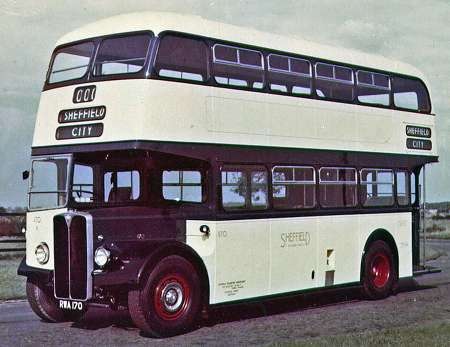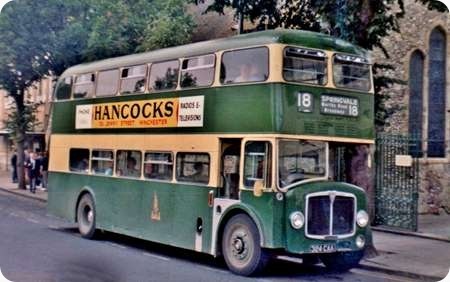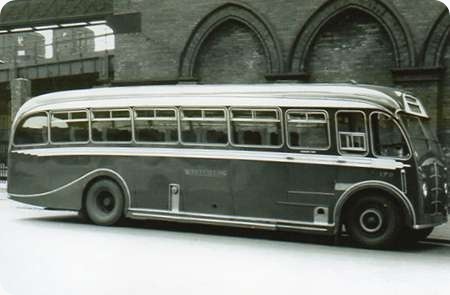Sheffield Corporation – AEC Regent III – RWA 174 – 2174
Sheffield Corporation
1953
AEC Regent III 9631S
Roe H33/25R
It’s November 1967 and Sheffield B fleet 2174 is at Central Bus Station ready for an hours journey round the City on the 9 Inner Circle route which is a category A service. The Inner Circle traversed the older inner part of the City through much industry and terraced housing. There were ten of these buses in the batch which were the first genuine 9613S models to enter Sheffield service. The preceding 1952 batch were actually the 9613A version modified in 1953 to synchromesh gearbox specification. 2174 and its fellows were long associated with Leadmill Road Garage being regular performers on the Bradway group of category B services. Platform A of Central Bus Station was on Pond Street itself and the bridge to the rear of the bus gave pedestrian access to the bus station from an elevated walkway on the opposite side of the road. Although much modified, Central Bus Station still exists on the same site still with loading bays where 2174 is standing. The footbridge though has long gone.
Photograph and Copy contributed by Ian Wild
03/10/13 – 08:51
Lovely buses with their Roe bodywork. Shallower windows than the Pullmans of the previous year but with subtly different upper windows from the "standard" (most common) Roe bodies found on the Regent III, Regent V, PD2 and PD3 deliveries between 1955 and 1960. [The front of the upper deck was also more raked.] Only ten of these, and only nine Pullmans, but along with the subsequent Regent Vs they seemed ubiquitous in the Greenhill/Bradway area of my youth. How I remember their musical gearboxes ans raucous exhausts.
David Oldfield
03/10/13 – 08:52
You make mention of category A & B services. I’d be interested in learning what these refer to and were there any other categories?
Paul
03/10/13 – 14:37
Paul. These were explained a year or two back on another post. Yorkshire was the home of several Joint Omnibus Committees (JOCs). They combined Corporation and Railway ownership to give regional services – in the same way that BET and Tilling fleets normally did. [In those regulated days, corporation routes were restricted to the town boundary.] Sheffield, unusually, had three fleets: A fleet owned by the Corporation; the B fleet jointly owned by the Corporation and British Railways’ Board; C fleet owned by British Railways’ Board. The JOCs were set up in the ’20s (1927/8 in Sheffield) – originally with LNER and LMS railways. Sheffield was continuously expanding from 1928 to 1974, hence the "extra" fleet. A fleet (to early twentieth century town boundaries); B fleet (covering territories taken over – primarily from West Riding CC and Derbyshire CC); C fleet for long distances (including Chesterfield, Gainsborough and Manchester – as well as Peak District with towns such as Bakewell and Buxton).
David Oldfield
03/10/13 – 14:37
Paul Sheffield had three categories of service These were the A which were within the city boundary and were wholly run by the corporation The B services which were joint with British RAil and covered the outer suburbs and finally the C services which were wholly the preserve of British Rail and were long distance services to places like Leeds and Manchester.
Each group of services had a fleet to run them all run by the general manager B and C fleet buses did not carry the city coat of arms just the fleet name Sheffield The C fleet was in some ways the most interesting as due to British Rail involvement Sheffield could buy Bristol and ECW products. They never bought Bristols but did buy Leyland Leopards with ECW MW style bodies and ECW bodied Leyland Titans.
The legal lettering on the C fleet showed the owner as the British Railways Board Although British Rail had involvement in Halifax Todmorden and Huddersfield this was to a far lesser extent than the Sheffield arrangements. The agreement was wound up in the seventies
Chris Hough.
03/10/13 – 14:39
Love the way the bodywork is built flush with the offside of radiator, RT-style. I always thought they looked smarter like this.
Chris Hebbron
03/10/13 – 14:41
Those straight-through exhausts were really something; the bark that the VWE-registered ‘tin front’ Regent III’s made, climbing up Firth Park Road past the park and the boating pool, on their way to High Green on the 73, is a sound I shall never forget. Elegant to look at too, especially in the Roe style livery as new, with dark blue window surrounds and blue front end. Truly marvellous machines.
Dave Careless
03/10/13 – 14:45
The stand on platform A where the bus stands, was not the no9 stand. This was on the end of platform B, virtually 180 degrees in the opposite direction. I used to catch them on my way home from the Army Cadets in Endcliffe. The nos 8 & 9 only had Circular on the destination blind, not City, so this may have been a duplicate, parked up ready for going on another route. In 1967 it would have been old & with all the Atlanteans we had, unlikely to have been on regular daily routes. By 1967 they were mostly using single decker’s on the 8 & 9 routes, (I used to catch these to work in Broomhill each morning). Not sure when, but they had Marshall & later Alexanders, occasionally a Fanfare. I think the Totley bus (Category B) also ran from platform A, they had these kind of buses on that route during the 50s & early 60s. I do remember them having a lovely booming exhaust sound going up the hills. The stand pictured was for the 33, 34, 35 & 36 routes (which I used throughout my school life) towards Heeley & beyond.
Andy Fisher
03/10/13 – 15:42
Expanding the comments by David and Chris, buses could run on any route, as the photograph shows, to meet traffic requirements. It was not unknown to find an A fleet bus on a B or C route, especially at times of holiday duplication into the Peak District. There must have been a complex re-charging system and sometimes mileage accumulated by one section and "owed" to another was run off.
Geoff Kerr
03/10/13 – 15:43
Andy. You are right that the Inner Circular and Totley were originally inside the bus station on Platform B, but I have a niggling gut feeling that one direction did eventually end up on Platform A. Deckers were used on the 8/9 until 1968 – I used it to get to King Ted’d from 1964-1971. In 1968, the early single door Swifts replaced deckers on regular day time service. They had Park Royal bodywork. [The only Marshalls ever bought were the W reg AN68 Atlanteans.] Alexander Leopards occasionally appeared at Rush-hour – as did early Leopards, ECW and Burlingham as well as Weymann Fanfare.
I feel that, partly because of the age, 2174 may have been doing a rush-hour extra and that the City may be to indicate it is terminating there.
David Oldfield
04/10/13 – 06:18
Thanks to David, Chris & Geoff for the info. Sheffield was clearly an interesting place to be bus wise back then.
Paul
04/10/13 – 06:18
2174 was originally part of a batch of ten delivered to the "B" fleet in 1953 which comprised numbers 168-177. According to CC Hall, they were renumbered 2168-2177 in 1967 to accommodate computer accounting and as the batch is given as being withdrawn during 1967-1968, presumably 2174 is nearing the end of its days.
Here’s a picture of 170 looking absolutely superb when new in the paint scheme used on Roe bodies before the general manager of the 1960’s decided he knew better!
Photo courtesy of The Tom Robinson Collection
John Darwent
04/10/13 – 06:19
In connection with the C fleet do not forget that they also ran to Bradford on service 66 joint with Yorkshire Traction and Yorkshire Woollen. In the 1960s I was a conductor with YWD and worked on this route. Sometimes our bus would develop a fault at the Sheffield end and then we would be given a STD machine as a change over. What a treat this would be and we did not want to give up the bus. I remember an occasion when a STD bus broke down in Heckmondwike and the crew were given one of their old Leyland PD2s as a change over. I suppose they thought they had seen the last of them.
Philip Carlton
04/10/13 – 08:41
But the Sheffield buses "given" to Woollen were not time expired. Just another "political" move. They were owned by the Railways and as that system had been superseded by NBC, the owner had not changed, just the operator. [Yes they were approaching the end of their lives.]
David Oldfield
04/10/13 – 11:11
In addition to YWD getting some ex Sheffield C fleet vehicles Halifax also received a number of Leyland Leopards with bodywork by Burlingham while Todmorden gained a trio of ECW bodied Leopards by 1971 all were in the Calderdale fleet. The Burlingham bodied ones did not last long but the ECW bodied trio passed to the PTE in 1974.
Chris Hough
04/10/13 – 17:23
I have long been aware of the Railway involvement at Sheffield, Halifax, Todmorden and Huddersfield and some of the above posts (and those previously) indicate how vehicles might be borrowed and mileage adjustments made or balanced.
What I do wonder is how other aspects of the operation worked.
For example were all the road staff employed by one body (presumably the Corporation), were they interchangeable between areas, and indeed how did the depot and maintenance and also the admin operation work.
One can imagine a most complex charging and recharging system with lots of room for argument.
Gordon Green
05/10/13 – 08:32
I have said as much before, but the place to stand was Snig Hill, waiting to cross to Castle Market. Barking AEC’s- some had got it just right, others chuffed like valve or governor bounce (those were the days)- but also the tin front Leylands with a seemingly continuous blast of compressed exhaust from a smaller pipe. The heat & blast would sweep across your legs. I remember a man shouting "That’ll singe yer nylons luv…"
Joe
05/10/13 – 08:35
Gordon I don’t know about Sheffield but in Todmorden there was only one depot while in Huddersfield the two depots were a motor bus depot for the JOC and a depot for the corporation owned trolleys (Huddersfield had no motor buses until the early sixties). Not only was there two depots in Huddersfield there was also two liveries a streamlined one (red and cream) for the corporation and a red one with thin cream bands for the JOC.
Halifax also has two depots at Elmwood one of which was nominally the corporations while the other was for the JOC. The Halifax livery was a standard layout for both fleets.
Chris Hough
05/10/13 – 15:40
I bought a book yesterday showing Pond Street bus station before it was covered, all scaffolding poles & corrugated iron roofs. It had a picture of the Totley bus stand, near the end of platform B. It was an early 60s picture. The bus was an AEC 3?, with what looked like a pre 1945 Weymann body, with the smaller drivers front window.
Did buses have a milometer? If not, how did management structure servicing dates? it would make it easier to use B & C category buses on A routes & vice versa.
Andy Fisher
06/10/13 – 07:55
Andy. If it was pre-war, it would have been a Regent (I). The AECs had a speedo and one other gauge. There would have been a mileage counter on the speedo. The immediate post-war Weymanns were 1947/8 Regent IIIs. I can remember Pond Street as you describe it before the mid-fifties redevelopment – as shown above on the post. [The vehicle behind 2174 – on the 71 – is almost certainly one of Greenland’s PDR1/1/Weymann (or MCCW?). They also used the first Fleetlines (951-3) on this route.
David Oldfield
06/10/13 – 07:57
When the JOC was wound up, Sheffield had five depots – Leadmill, Townhead Street, East Bank, Greenland and Herries. The last three were purpose built for buses. I remember Townhead St being closed in the late 60s but I believe the other four survived at deregulation.
The JOCs did not employ any staff – crews and office staff were all employed by the Corporation, which also owned the garages.
Geoff Kerr
06/10/13 – 14:22
I notice that 2174 has an advertisement for Wigfalls. This was a chain of shops selling TVs and other electrical goods with their head office in Sheffield. We rented our TV from the Dewsbury branch and the service was first class. I suppose their demise was due to the rise of PC World/Currys. Don’t get me started about their lack of service. A month ago I bought a new lap top from them only for the hard drive to pack up. On returning the machine to the shop they had the cheek to say it would cost 50 quid to put right until I quoted the Sale of Goods act then they said it would be repaired under the manufactures warranty. Come back Wigfalls!
Philip Carlton
12/10/13 – 16:27
I remember Wigfalls in Leicester, I bought the latest gadget for my wife, a steam iron, for half-a-crown (12.5p) a week on HP. Those were the days when most buses only had two dials to look at – the speedo and the brake – either vacuum, hydraulic pressure or if you were lucky, air pressure.
Mr Anon
23/10/13 – 15:49
My memories from mid 50s to mid 60s, was that Wigfalls was a hire now, pay weekly firm. Everyone had their twin tub Hoover washers from them & fridges when they became available, I suppose because of the cost. People also hired their TVs from them, either weekly or with a coin meter on the back. They were a massive firm, with loads of Bedford CA vans, now no more.
Back to the Circle route 8 & 9. Around 1980 to 1983, I had a garage on the island on the bottom of Sutherland Road & Carlisle St. At that time they were using Alexander Y types, both bus & coach equipped. Climbing the steep hill was a beautiful booming noise from the Leyland engines. Maybe, the AECs had quietened down by them.
Andy Fisher
23/10/13 – 16:40
Andy, the Y types were strictly speaking DPs. Sheffield/SYPTE never had any bus versions. Yes they would have resounded off the surrounding walls. By the mid ’80s I think all AECs would have departed.
David Oldfield
23/10/13 – 17:37
For a short while, I regularly drove a preserved SBG Y type Leopard (and X reg Midland – one of the last). It was always fun accelerating along narrow, built up, roads. You don’t get sound effects like that from the modern sewing machines. [Mind you, I think an 0680 Bristol RE makes an even better sound!)
David Oldfield
24/10/13 – 07:53
Can you still rent a television? If it goes "on-the-blink" can a "TV-repair-man" still come out in a van to fix it?? Along with Wigafalls so too have gone DER and Rediffusion. So, apart from locally-liveried buses, local advertisements seem to have gone the same way . . . along with local ITV stations. However, local(ly-designed) bus stop flags seem to be coming back into fashion, to replace the DoE 1970s design. Lose some, win one?
Philip Rushworth
26/10/13 – 07:19
Not quite sure what the Alexanders were, it was some had large sloping windows & some had smaller, more upright numerous ones.
Andy Fisher
23/05/15 – 07:08
Does anyone out there remember Herries Road bus garage, I lived next to the garage in the 1950’s I remember it being built.
Glynn Evans
 Vehicle reminder shot for this posting
Vehicle reminder shot for this posting
16/08/18 – 06:04
Whoever said modern buses were like sewing machines…. I’m not so sure..the early Omnidekas at Brighton & Hove used to make a fantastic noise as I drove them up Elm Grove on 22s & took me back to the noise of NWRCC Royal Tigers on some of the hilly local routes round Matlock in the 1960s
Ian Hudson
Quick links to the - Comments Page - Contact Page - Home Page




